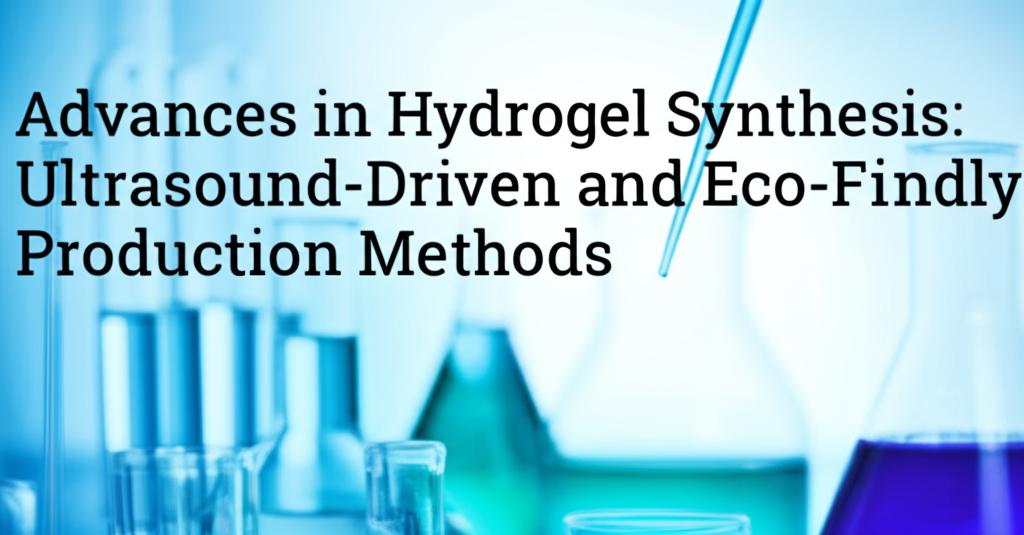Hydrogels, with their unique three-dimensional networked structures and high water content, are at the forefront of materials science, finding applications in diverse fields such as biomedicine, agriculture, and environmental remediation. The push for greener and more efficient manufacturing processes has spurred significant innovation in how these versatile materials are created. Emerging techniques, particularly those leveraging ultrasound technology and other environmentally conscious principles, are revolutionizing hydrogel production, paving the way for more sustainable and precisely engineered materials.
Traditionally, hydrogel synthesis often involved methods that could be energy-intensive, time-consuming, or reliant on potentially harsh chemicals and conditions. Recognizing these limitations, researchers have actively sought alternatives that not only enhance the efficiency of production but also align with the growing global emphasis on environmental responsibility.
The Power of Sound: Ultrasound-Assisted Hydrogel SynthesisUltrasound-driven synthesis has emerged as a particularly promising advanced method. This technique utilizes high-frequency sound waves (typically >20 kHz) to induce acoustic cavitation – the formation, growth, and implosive collapse of microbubbles in a liquid medium. This cavitation phenomenon generates localized hot spots with extremely high temperatures and pressures, as well as intense shear forces and shock waves. When applied to hydrogel precursor solutions, these effects can dramatically accelerate polymerization and crosslinking reactions.
Key advantages of ultrasound-assisted hydrogel synthesis include:
- Accelerated Reaction Rates: The intense energy input from cavitation significantly speeds up the chemical reactions involved in gel formation, often reducing synthesis times from hours to minutes.
- Enhanced Homogeneity and Properties: The powerful mixing effect of ultrasound leads to more uniform distribution of monomers, crosslinkers, and other components, resulting in hydrogels with more consistent structures and improved mechanical and functional properties.
- Milder Reaction Conditions: Ultrasound can often initiate or accelerate reactions at lower temperatures and pressures than conventional methods, reducing energy consumption and allowing for the use of heat-sensitive biomolecules.
- Reduced Need for Initiators/Catalysts: In some cases, the energy from sonication can reduce or even eliminate the need for chemical initiators or catalysts, some of which can be toxic or difficult to remove from the final product. This makes the process cleaner and the resulting hydrogels more biocompatible.
- Better Control Over Structure: By tuning ultrasound parameters such as frequency, power, and sonication time, it's possible to exert greater control over the hydrogel's pore size, crosslinking density, and overall architecture.
Beyond sonication, a broader spectrum of eco-friendly strategies is being integrated into hydrogel synthesis:
- Utilization of Natural Polymers: There is a growing trend towards using abundant, renewable, and biodegradable natural polymers like cellulose, chitosan, alginate, hyaluronic acid, and gelatin as building blocks for hydrogels. These materials inherently offer better biocompatibility and a reduced environmental footprint compared to many synthetic polymers.
- Green Solvents and Reagents: Replacing hazardous organic solvents with water or other benign alternatives like supercritical carbon dioxide or ionic liquids (when used responsibly) is a cornerstone of green chemistry in hydrogel production. Similarly, the selection of non-toxic crosslinkers and other reagents is crucial.
- Photopolymerization: Using light (often UV or visible light) to initiate polymerization offers excellent spatial and temporal control over gelation. This method can be very rapid, energy-efficient, and can often be performed at room temperature without the need for harsh initiators, especially when coupled with photo-sensitive natural polymers or biocompatible photoinitiators.
- Enzymatic Crosslinking: Enzymes can be employed as highly specific and efficient catalysts to crosslink polymer chains under mild, physiological conditions. This approach is particularly valuable for biomedical hydrogels as it avoids potentially cytotoxic chemicals and harsh processing.
- "Click Chemistry" Reactions: These are a set of highly efficient, specific, and biocompatible reactions that can form hydrogels rapidly under mild conditions, often in aqueous environments, generating minimal byproducts.
- Solvent-Free or High Solids Content Reactions: Developing methods that minimize or eliminate the use of solvents altogether, or that operate at very high concentrations of precursors, can significantly reduce waste and improve process efficiency.
The adoption of ultrasound-driven and other eco-friendly synthesis methods offers a multitude of benefits. These include a reduction in energy consumption, decreased reliance on toxic chemicals, minimized waste generation, and the production of hydrogels with enhanced purity and biocompatibility. This shift is critical for applications in drug delivery, tissue engineering, wound healing, and sustainable agriculture where safety and environmental impact are paramount.
Looking ahead, research continues to focus on further refining these green synthesis strategies. Efforts are underway to scale up these processes for industrial production while maintaining their eco-friendly advantages. Combining different green techniques, such as using ultrasound to accelerate the polymerization of natural polymers in aqueous solutions, represents an exciting avenue for creating next-generation hydrogels. The development of "smart" hydrogels that respond to multiple stimuli, synthesized through these advanced and sustainable routes, will undoubtedly unlock even more innovative applications in the years to come. The journey towards truly green and efficient hydrogel production is well underway, promising a future where material innovation and environmental stewardship go hand in hand.

